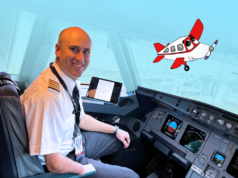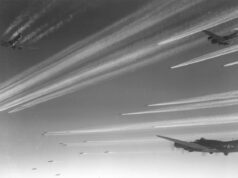
As airline flight crews, we have always been at a disadvantage when it comes to defending ourselves and our passengers, inflight as well as on the ground. We’re so preoccupied with doing our jobs, we rarely notice the signs of a potential attack. We’re trained to be people-pleasers and never touch another person without their permission. We’re in tight, confined spaces and often strapped to a seat. We can’t carry things that might be used defensively, we rarely have the element of surprise as an advantage and usually lack the training to survive an attack.
I am an airline pilot and a martial artist. I hold a first-degree black belt and I’ve spent 30-plus years learning, adapting and working to condense, simplify and polish my skills to be the best I can be at both endeavors. My contribution here, Self-Defense for Flight Crews, is written in three parts to allow you time to absorb a different way of thinking and seeing things as a street fighter, both in the air and on the ground. The common denominators in any form of self-defense are ACA: AVOIDthe threat / CONTROLthe threat / ATTACKand neutralize the threat.
In Part 1 we’ll be exploring the thought processes involved in any attack or threat situation. Why we think the way we do, why our potential attackers think the way they do and how they’re counting on us to react in order for them to succeed. In every attack situation, the mindsets of the intended victims are a major determining factor in whether they survive. Mental martial arts is a chess game. If you know how to play, you can win. The tools and targets you’ll learn in Part 3 are the Chess pieces and the rules of the game to be used to your advantage after you’ve set the stage for winning. You can reverse the role of victim your attacker thinks you’re going to play in his movie. This is how you choose your own role and write your own script.
PART 1. MENTAL MARTIAL ARTS and the OODA LOOP
CONTROLLINGthe threat: Don’t be the prey when you can become the predator.
On 9/11, cockpits were broken into, the captain and first officers immediately slaughtered, and airliners used as missiles to kill thousands of passengers, crew and innocent people on the ground. The pilots at my airline weren’t given a reason why we were being directed to immediately land at the nearest suitable airport. I later asked management why our flight crews weren’t told that people were breaking into our cockpits and crashing airliners into buildings so that we could take precautions. Management’s response: “We didn’t want the pilots to panic.” Aside from the unintended insult to people, many of whom were former military and trained to function calmly in emergencies, in my opinion, this decision put us in a more dangerous situation than telling us what was happening would have. It was particularly necessary because our pre-9/11 “common strategy” taught us not to resist hijackers and to take them where they wanted to go which was based on the assumption that the hijackers didn’t want to die. Knowledge allows us to deal with the problem. A lack of knowledge allows the problem to deal with us.
 The pilots of United Flight #93 were in the process of reading a warning message from dispatch just as the terrorists broke into their cockpit and killed them. The terrorists had planned to attack all four airliners simultaneously, within a 15-minute window, to avoid immediate detection. Their signal to begin was the 10,000-foot bell. Flight #93’s 15-minute gate-delay resulted in dispatch finally sending them a warning that cockpit incursions were occurring and airliners were being flown into buildings. Their warning came 25 minutes after the Twin Towers and the Pentagon had been hit. Timing, preparedness and knowledge is everything.
The pilots of United Flight #93 were in the process of reading a warning message from dispatch just as the terrorists broke into their cockpit and killed them. The terrorists had planned to attack all four airliners simultaneously, within a 15-minute window, to avoid immediate detection. Their signal to begin was the 10,000-foot bell. Flight #93’s 15-minute gate-delay resulted in dispatch finally sending them a warning that cockpit incursions were occurring and airliners were being flown into buildings. Their warning came 25 minutes after the Twin Towers and the Pentagon had been hit. Timing, preparedness and knowledge is everything.
After the passengers and cabin crew were told by friends and family that they were not going to survive what they thought was just a hijacking, their mindsets were changed which changed their actions, and saved the lives of many people in either the White House or Capitol in Washington D.C. If the pilots had received that information a few minutes earlier, it may have changed the results of that day and saved their lives as well. Knowledge is not something to be suppressed and feared, it’s something to be used to avoid the fear that comes with being unprepared. In the days, months and years following 9/11, flight crews received little or no instruction from their airlines or their unions on how to survive a terrorist attack on our aircraft. Our flight crews, left without direction, felt vulnerable after 9/11.
Flight crew self-defense preparation and situational awareness help us to create a safer environment in the air and on the ground, at work and at home. We spend half our lives traveling in unfamiliar cities, hotels, airports and other venues that put us more at risk than the average person. With decades of experience in the martial arts, I felt I should start including basic, effective self-defense in my captain’s briefings. “I can’t make you a martial artist in ten minutes, but I canshow you how to think, move and see things like a martial artist,” I told my flight attendants. “As a black belt, I can also give you some basic tools and targets that don’t require a great deal of strength or accuracy, but will neutralize the threat very effectively.” I didn’t know if including self-defense would be appreciated or mark me as a weird captain, but it was worth the risk if one person benefitted.
I was pleasantly surprised by their enthusiasm and gratitude for these short briefings. One of my flight attendants said, “All our recurrent security training has told us about dealing with a 9/11-like event is that we should stand in front of the cockpit door and die to keep the terrorists from getting in, so that the pilots have time to call in the military jets to shoot us down.” That misunderstanding worried me. “No! Your job is to identify the threat, stay alive and take out the bad guys with help from your passengers and crew. A pilot’s job is to secure the cockpit and let the military know we’re still in control of the aircraft so they won’tshoot us down.” Several months later, a group of flight attendants asked me if they could petition the company to teach this in their training. I advised them that it was likely a lost cause and would be refused by the company’s legal department. What I was teaching them was survival street-fighting, specifically designed for flight crews struggling to survive in close quarters. It was designed to result in damage to an attacker. If necessary, it could result in lethal damage to stop the attacker and save lives. There is a certain amount of trust involved in the student using what they’re taught appropriately. Legal departments and corporations don’t function on trust unless they have no choice. The difference between management, legal departments and flight crews is that flight crews, can’t function without communicating, cooperating and trusting each other.
I still teach flight crews, corporate employees, individuals and private groups the ACA (Avoid/Control/Attack = Neutralize) method of mental and physical self-defense. ACA is the result of 35 years of martial arts training and teaching, including interaction with law enforcement as a Police Aerial Patrol Pilot, and Federal Flight Deck Officer (FFDO) Training at the Federal Law Enforcement Training Academy (FLETC). What I first told my crew still applies; I can’t teach you how to be a martial artist in one article, but I can show you how to think, react and move like one and give you a few tools and targets that can save your life.
THE MENTAL ASPECTS OF STREET FIGHTING MARTIAL ARTS
THE OODA LOOP: 1. = Observe 2. = Orient 3. = Decide 3. = Act
The OODA Loop is a familiar term to most law enforcement and military combat veterans which they use to their advantage. The trap in the OODA loop is the Decidestep when confronted with a threat. It paralyzes one from acting. We never reach the Act portion of the formula, but just keep circling the loop in Decide. It can, however, be transferred to your attacker making them feel less the predator and put them in the mindset of the prey.
A mind caught in the Decideportion of the OODA Loop is a blank slate of doubt waiting for someone to write on it. Either you write something on it and break the cycle by doing something, even if it’s wrong, or someone else will. That someone else will most likely be your attacker. Taking action breaks the trap of indecision and puts your attacker in the Decidecycle instead, especially if your reaction wasn’t what they expected. Now he’s the one wondering how to respond because you’re not following the script he’d written for you in his mind. A deer in the headlights is an excellent example of being trapped in the Decide portion of the OODA Loop. Though it is a true statement that your attacker will most likely be the one who writes on your blank slate if you don’t, it is not always the case.
A student in one of my “Surviving Active Shooter Situations” classes asked me a good question. “I know we’re supposed to run if we can, hide if we can and then fight if we have no other option; but if I attack the shooter, how do I know if anyone else will help me?” I explained that most people wait for others to take action and then follow whatever is making the most noise and is aggressive, especially if you bring them into the sphere of action with a short loud command like; “Get him!” “Take him down!” or “Help Me NOW!” It not only snaps them out of Decideand gives them direction, but yelling a directive empowers you, puts you in a predator mindset and leaves your attacker feeling more like the prey wondering what’s going on. Prey have a lot more to think about and are always one step behind the predator because they are reactive. Predators are proactive. If you want to light a fire and survive, be the spark. The rest will take care of itself. Besides, if you can’t run and you can’t hide, your decision is already made for you. fight or die.
STRESSED OUT MIND GAMES
The tricks our minds play on us in stressful situations would be admirably creative if they weren’t so deadly. Denial, substitutes and justifies a more acceptable scenario in place of reality. Retreat is a reflexive choice to be uninvolved in a situation that’s unavoidable. These reflexive responses result in becoming paralyzedwithin Decide-mode with tunnel vision.With knowledge, these things are not only avoidable, but transferrable to your attacker. Keep in mind that a real fight gives you little or no warning and usually lasts 30 seconds, which is a long time. I’ll use the 9/11 attack scenario I gave to my cabin crew as an example of how this works and how to break yourself and others free of these mental traps.
Denial and Substitution:
From the passengers’ viewpoint, they had just been thinking about other things and enjoying a book, meal or movie and were transported to seeing someone struggling with a flight attendant and an attempt to cut his/her throat. Their first reaction is horror and confusion. “This can’tbe what it looks like!” Immediately, their minds start the desperately creative process of trying to fabricate a more acceptable, less horrific reason for what they’re seeing. “Maybe she slipped and he’s helping her up.” “He spilled red wine on her and he’s trying to clean it off.” “This must be a movie being filmed and I missed the notice.” All of this and the fact that no other passengers are reacting them keeps them trapped in denial and paralyzed in the OODA Loop. Meanwhile, you’re not taking advantage of all the resources you have available to you. That’s what allowed four people to take over an airliner with 40-plus people on it who can, but don’t, fight back.The blank slates are waiting for your direction. Don’t assume the obvious is enough.
Winning the War of Minds:
Your first step to winning the War of Mindsis already completed. You’re reading this article, taking action to prepare yourself and acknowledging that this, hopefully won’t, but could happen to you. As my Special Forces instructor told us in FFDO training, “Play a movie in your minds where you always win and never stop fighting, no matter what. Do it before you’re in an emergency situation. You won’t have time when it’s happening to you.”
Tunnel Vision:
In moments of extreme stress people tend to focus more on a few elements of the emergency to the exclusion of the big picture. Don’t stay so focused on getting the steak outside to the barbecue that you run into the closed sliding glass door on your way out. Don’t lose situational awareness. Pilots sometimes find their focus so stuck on a few instruments in an emergency that they don’t see the bigger problem looming on the horizon. This happened on Eastern Airlines Flight #401. They were all so intent on solving a potential landing gear problem (which turned out to be a burned out lightbulb, not a landing gear malfunction) that they let the autopilot fly them into the ground. Always remain situationally aware.
Activate your Troops:
You’re fighting for your life and trying to adhere to your “I always win” script, but your back-ups are still seated in zombie-like trances waiting for their blank slates to be written on. You are a familiar, uniformed crew member who, by implied authority, is to be trusted. The powerful short yell, “Ki’ai!” is a potent martial arts technique in its own right, meant to stun and temporarily blank out the opponent’s thinking and empower you. In addition, it keeps you breathing. Most people hold their breath in a fight and wear themselves out unnecessarily. Breathe.
Shout no less than one thing and no more than three, and keep shouting. Under stress, the mind can’t process more than three things. I instructed my cabin crew to first yell “Help me!” This gives the passengers and your fellow crew members permission and direction to get up and interact with you. It also implies that the other individual is the bad guy intent on doing harm.
The second directive I suggested that my crew yell, was “Kill them!” (You can substitute, “Stop them!” if you’re certain it’s not a deadly situation.) The reason this drastic command is important is that it gives your back-up a reality about how serious this situation is and to what lengths they are allowed to go to stop it. It also has an empowering effect on your own fighting and scatters your attacker’s attention and resolve. People aren’t used to touching someone else without their permission, much less with intent to restrain or do harm. They have to be given permission by you. Otherwise, they may think getting up and tapping your attacker on the shoulder with the polite request that they, “Please stop doing that,” is what you want.
Another advantage to yelling is that the pilots can hear you and are immediately made aware of the situation behind them. These things happen very quickly and unexpectedly. You won’t have time to get to the phone and tell them what’s going on before it’s over. You can and will WIN THIS.
Get ready for Part 2 in next month’s Aero Crew News. We’ll explore situational awareness and how, when, and where to look for potential high threat situations. At what level of situational awareness are you currently operating? We’ll give you some daily exercises to increase your habitual situational awareness so that it becomes instinctual. After all, being situationally aware enough to avoid a threat means you’ve already won the battle in the first round.






















































